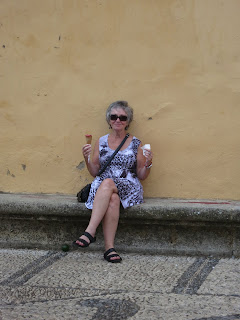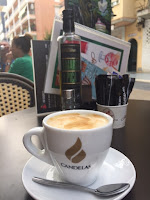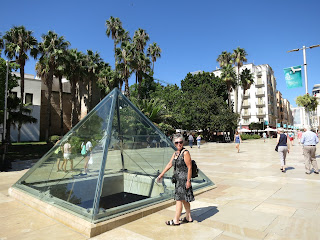(Monday, September 24:) WE CAN'T BE LATE FOR A VERY IMPORTANT DATE!
Since we are 35 minutes from Malaga, we decided to head to the city early, even though we did not have to be in front of the Albeniz Cinema until 7:00 when Miguel Alba told us there would be a newspaper journalist to interview us at the front door. What?! This sounded like some serious stuff, so we left at 1:00. On the ride beside the Mediterranean, I saw a woman in a pretty yellow dress and heels riding a scooter along beside us. Only in Europe?


We found a deeply inclined parking garage (glad I wasn't driving) and I led the way toward the El Pimpi Restaurant for lunch at 2:00, which is across the tiled walkway from the cinema. I have eaten here several times as I was first introduced to this place by Vicky last year. It is surrounded by huge red and white polka-dot cups filled with flowers, mostly red geraniums. I told Steven my favorite menu item was called
Ensalada Malaguena made with potato (of course) salad,
bacalao (cod) oranges and just a little bit of
salmorejo (cold Spanish soup) drizzled across the bowl's edges. He said yes and we looked at all the bullfight posters that covered the wall while we waited for our meal. Oh, and he had his beer and I had
tinto verano con limon. Delicious just as I remembered.
The historic cinema building was beautiful and the documentary poster was bold and inviting. Since this was a premiere for private invitation only, it made the evening more magical. There was supposed to be a full house, 300 seats. Again, we thought..."What are we going to do since we are still four hours early?"
Shopping? No, I'd have to carry a bag. Exploring? No, it was pretty hot for that. Look for Picasso's statue at Park Merced near Picasso's birthplace? Yes, it would be shady and cooler. But it wasn't... so we found Bar Negro near the cinema, found chairs and had cold drinks. A wonderful breeze flowed through the narrow stone passageway, but we couldn't stay there all day. We walked past the Roman Theater, looked at the old buildings and poked into key holes in the ancient doors.
 |
| When I found the Spanish woman painted on the construction wall where I'd stood last year with Rina Rien, I had to take another one. It is my Facebook profile photo! |
Would the Cathedral of Malaga be cooler? If so, it would be worth the 5,50 euros to gain entrance. No, it wasn't, but it was enormous and beautiful with the high, high vaulted ceilings and golden inlaid shrines. We discussed all the poor who went hungry while the church was covered in gold. The gift shop was the coolest area around us...on the way out. (smile).
 |
| This mural is painted on the side of the building where Picasso was said to have been born. |

By that time, the heat was making us limp. We headed back to the breezy cafe in the shade. More cold drinks and then we heard someone call Steven's name. A man from Granada recognized him as the person who helps so many Spaniards find their family through the Hawaiian Spaniards FB site! We had a good visit and then two women found him, kisses, hugs, introductions...and the clock was ticking toward seven o'clock. These women were Spaniards with relatives in California and the smiles just wouldn't stop all around us. Then, cousins approached us, Angela and her mother, Mari were there to see the documentary...and then the crowd expanded, Miguel Alba began to bring others toward us and Eterio Ortega the producer was there...more Spanish kisses and hugs. Maria Angela and her daughter Esther arrived with her brother Antonio and his wife and mother in law. Jose Luis Sanchez from Algodonales and then the journalist from the newspaper arrived with her photographer. She interviewed me, then Albert Marques, the other descendant from Gilroy, CA and then Steven. All the questions related to the documentary, our research and our love for Spain. Pretty amazing and the documentary hadn't even started yet.
 |
| This is the photo taken by the El Sur photographer for the newspaper article. |
WHEN IT WAS CLOSE TO 7:45, we were led to reserved seats in the front row with our names on the chairs. It felt like I'd walked in on a red carpet. Well, I did have red heels on...did that count? Before the show, the producer (Eterio), the director of the University of Malaga and two other men introduced us and told us how the documentary started with Miguel Alba's research and his request from the university (where he works) to back the project. (We have our fingers crossed that National Geographic will buy the film so Americans can see it on television...or another venue).
AND THEN THE DOCUMENTARY began. To say that I felt gobsmacked when I saw myself and my Aunt Millie at the beginning would be an understatement. To hear her talk about her parents coming from Spain and walking with me through the Winters Cemetery near my grandparent's gravestones made me breathless. And then the tears came. Off and on through the documentary, I saw myself, heard my words as I read from The Girl Immigrant narrating a lot of the scenes and the screen was blurry through my tears again. When Steven Alonzo's interview started and I saw his family photos on the huge screen, I saw his face drenched with emotion too. And then Albert Marquez began his speech on the huge screen, mostly in Spanish (he's a Spanish teacher). It was too amazing for words. And then I saw Gloria Lopez from Winters and her husband walking hand in hand through their orchards, saw her cutting up peppers and making a chicken and vegetable meal...and then there was Michael Munoz from Placerville, the creator of the Hawaiian Spaniard's site. His interview was natural and funny as he walked through his vineyard and talked about his grandparents being so poor they ate snails from their garden. All the other descendants spoke and I felt as if there was a time warp and all the gentle stories, emotions and our love for Spain washed over me. It was 75 minutes long and I was afraid to blink for fear of missing something. Steven and Albert agreed they felt the same way. The camaraderie between us was palpable and I know we will all meet one day again.
THIS MORNING, our interview was already in the El Sur newspaper. Despite the journalist spelling my name as Patricia Steeve instead of Steele, I was still feeling the glow. And we were very surprised it was already in print --- overnight! We each bought a newspaper to take home of course.
TODAY (TUESDAY) Miguel wanted us to meet him at the University of Malaga this morning at 11:00, so we headed off again in El Carro II and made it in plenty of time. We had no idea what was in store for us. When were were led into a fancy conference room with the co-directors and Miguel Alba on one side of the table and Steven, Albert and I on the other side, we all looked at one another with doe in the headlights eyes. And then the photographer began taking photos and the Spanish flew across the table. Albert is fluent in Spanish and helped me, as did Steven. What a day! And it wasn't over yet.
Miguel drove us to a beach-side restaurant where we met German, the photographer from the documentary and we all had tapas and wine with the sea beside us. Russian Salad, fritos (fried potatoes that looked like fat, chunky potato chips) and the guys were refreshed with cold beer.
Albert Marquez and German Nieto
Vicky's novio (boyfriend) Antonio invited us to his restaurant Las Flores and prepared a huge paella meal for us. And that was after wine, olives, cheese, shrimp in garlic oil and lots of bread. I was surrounded by six Spanish men and it was pretty sweet. When Miguel's wife arrived to join us, it added to the atmosphere; she is vibrant and so very proud of her husband for making this documentary happen and made us feel part of their lives.
 |
| Antonio brought out the paella...and wouldn't let us pay for this huge, gorgeous meal |
 |
| He asked if I wanted to taste a very special RESERVA muscatel wine after the meal? Of course. |
And we still were not finished! Vicky asked all of us to meet her in a roof-top bar nearby and Miguel and his adorable wife, Isabel, led us there. I took this photo because I love how they are with one another. Holding hands all the way. He explained that when you are stressed that you have "ants in your stomach" but when you are in love, you have "butterflies in your stomach." He told us this difference because he said after 35 years of marriage, he still gets the butterflies when he is with her.
 |
| A beautiful romance - Miguel Alba and his wife "Izzy" Isabel |
 |
| Steven Alonzo and I at the roof-top bar with the beautiful cathedral in the background |
 |
| German Nieto and Albert Marques |
 |
| Albert Marques, Steven Alonzo and Vicky Martin |
I tried to think of the best part of the day and I believe it was when German, our photographer and good friend told us as we sat beside the sea, that he'd worked on many documentaries but the one for us did not seem like a job. It was like working with family because he felt so connected to all of us. He said Eterio and Miguel also felt connected like a big Spanish family. And Vicky? Well, she IS family... German, Eterio and Javi (the translator who was also the audio man during the interviews in California) asked me to give Aunt Millie a good hug and kiss when I returned to America.






























































